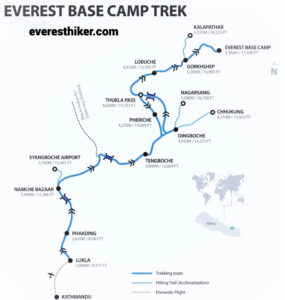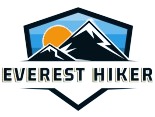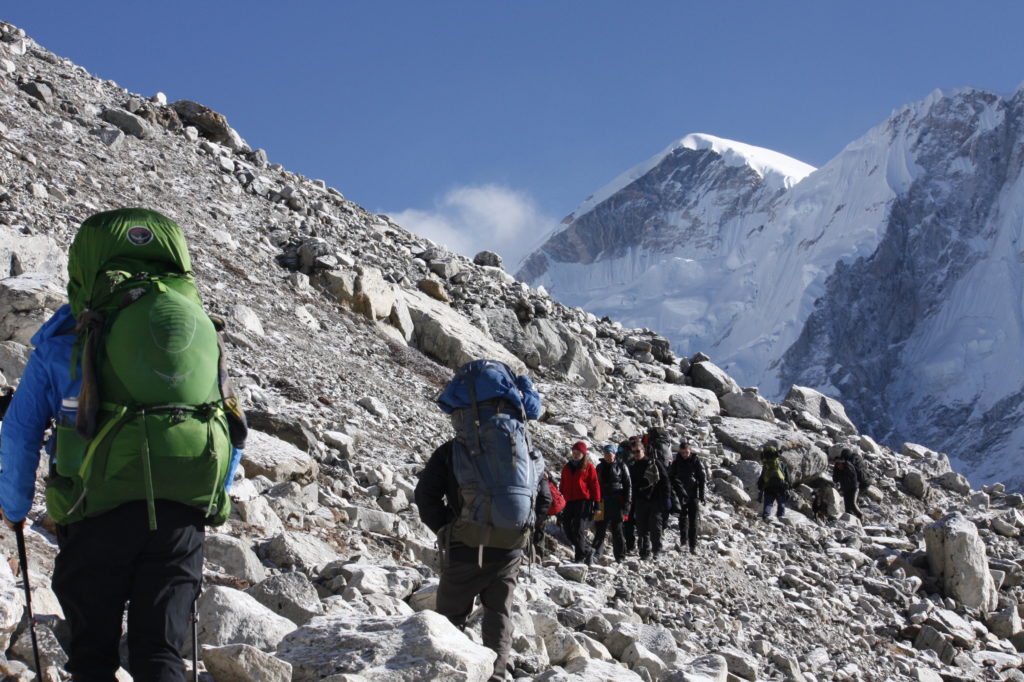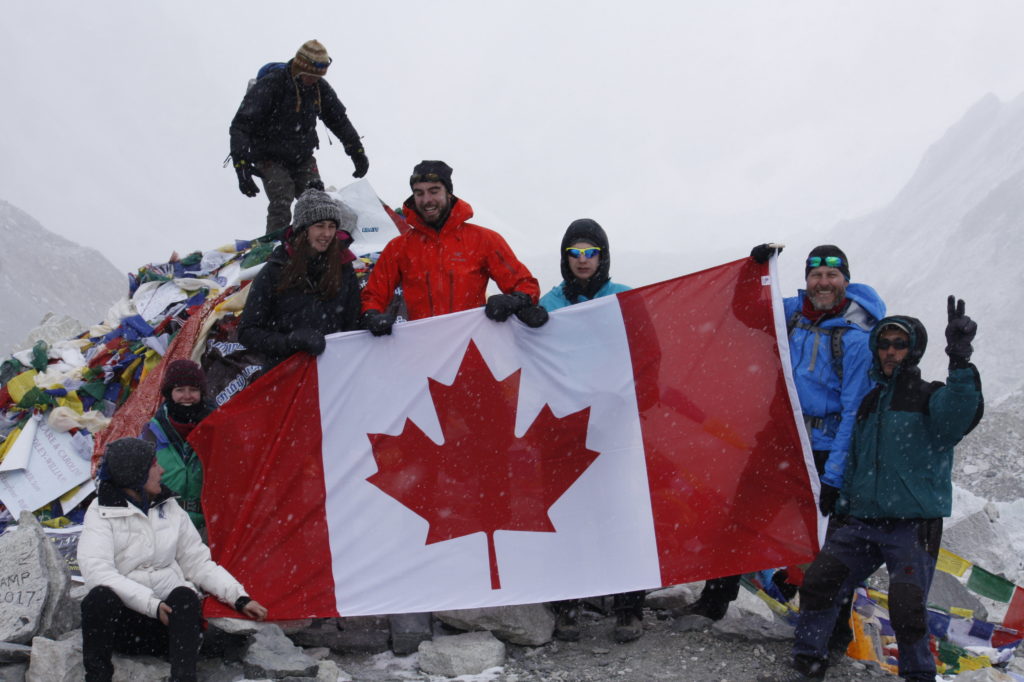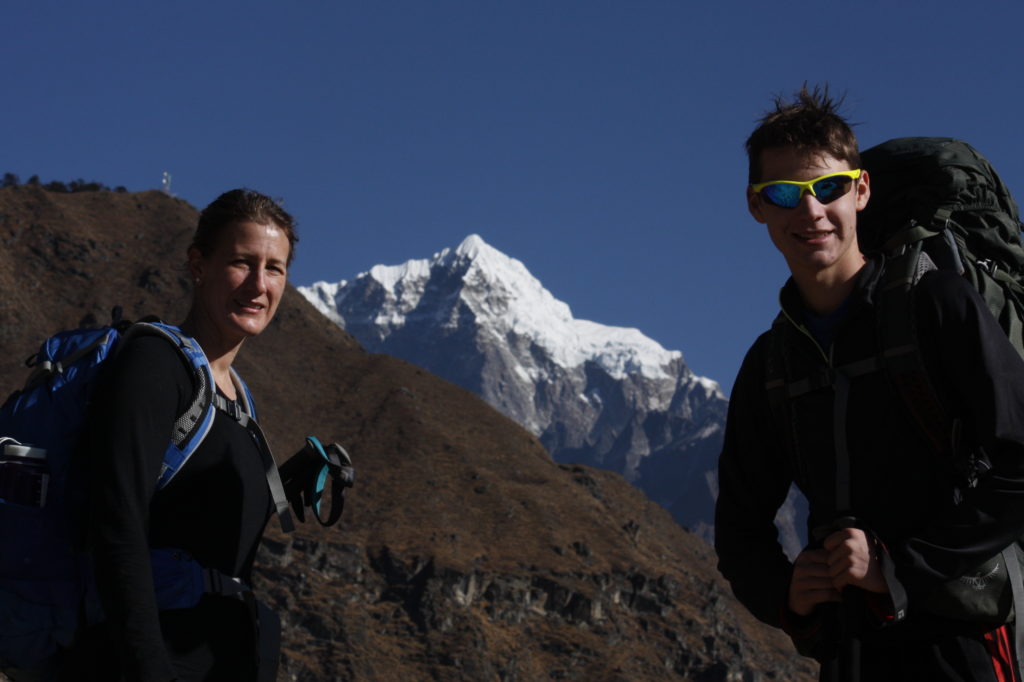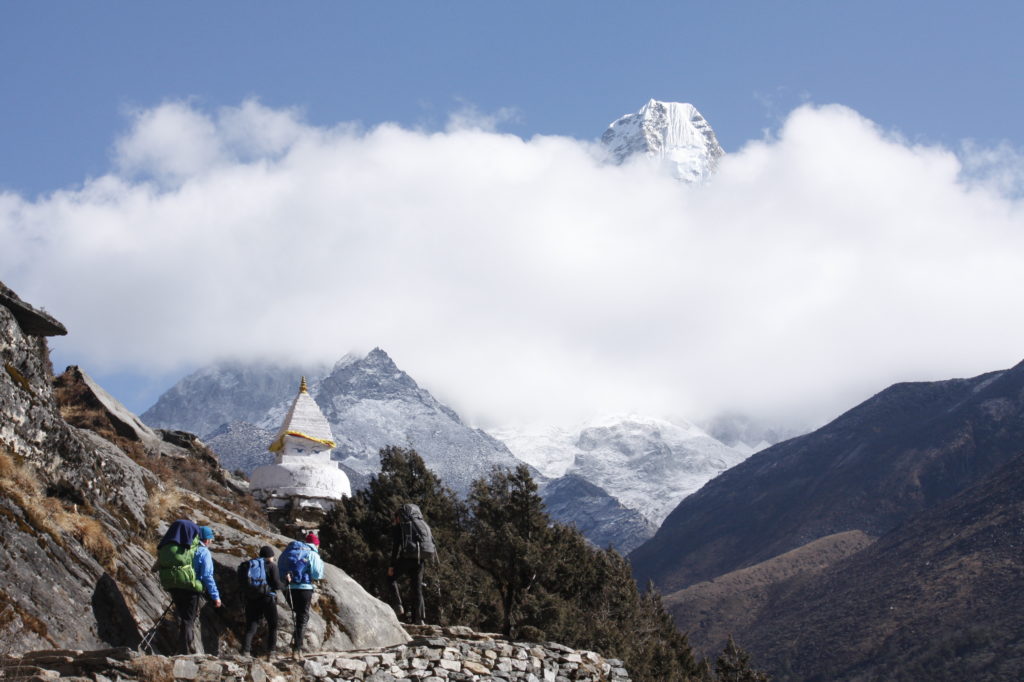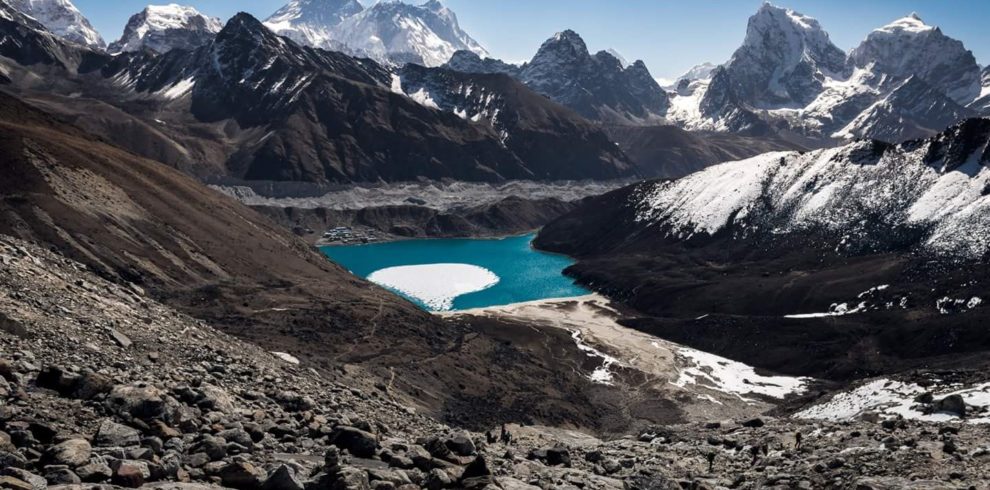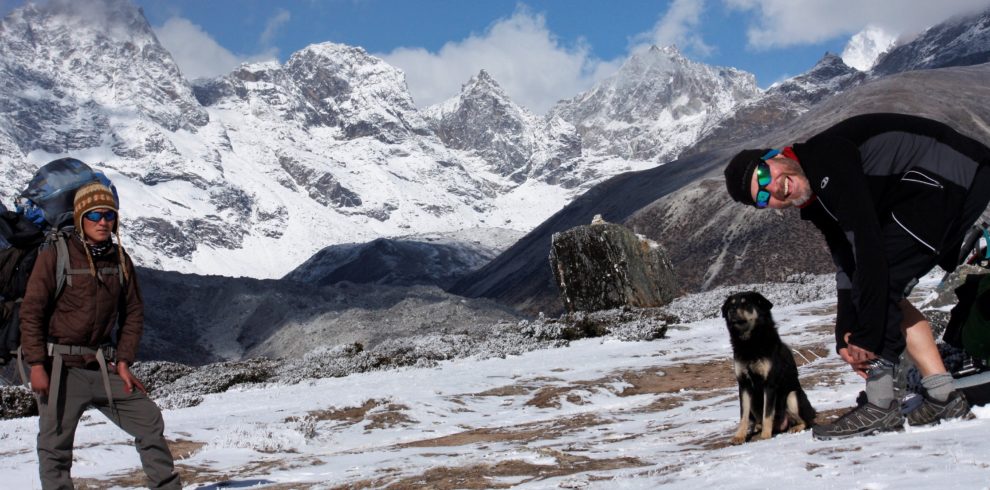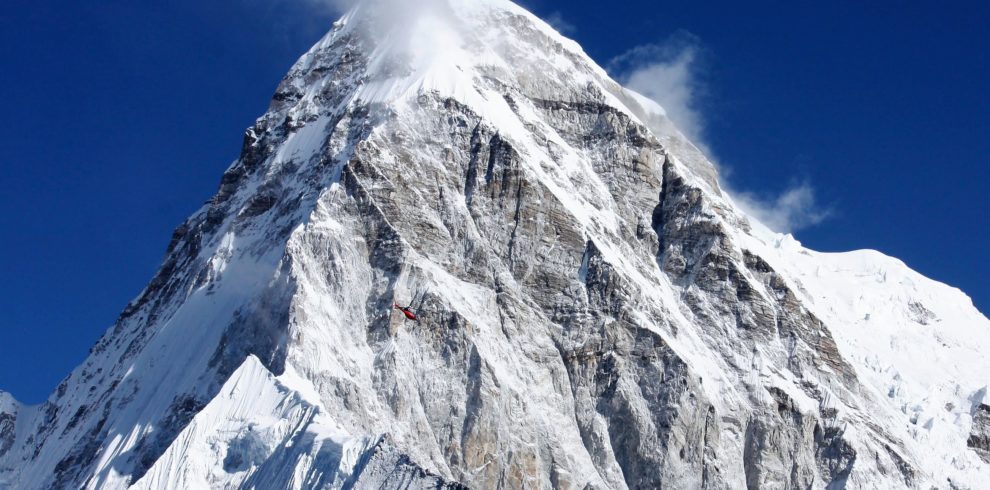Everest Base Camp Trek in Nepal is renowned as the world’s most iconic journey. The Himalayas base Kalapather viewpoint sits on the lap of the world’s highest peak. The outstanding viewpoint permits us the grandest views of three of the world’s highest mount. Trip to Everest base camp offers Lhotse and Lhotse Shar in a single glance. The epic trip leads us on the foot until the Mount Lap. To reach, Base camp is a sense of adventure, and love of nature. Nevertheless, this nirvana exploration is part of lifetime achievement. In meets these challenges, you have to endure physically difficulty. And to get to, you have to feel the mountains, from inner heart. Ultimately, the thin air saps your strength up to Everest base camp.
Moreover, trek to Khumbu might feel an evolving and quiet pride in your progress. Ready for that together Feel the mysterious forces of the earth. Trek has created astounding high peaks and deep valleys. You feel awe at you to be a small moving part of such a mountain paradise. Finally, you will be enjoying the most gratifying wilderness.
Everest trek itinerary provides us unique blending of nature. More, with the ambient peaceful spirituality of mountains. The Buddhist culture and its tolerances with witnessed in the Chortens let our peace. Equally, we can extend your trip by joining with Gokyo valley. Gokyo valley Chorla pass is too alluring and intoxicating explore it with enough time. We will feel blessed by their mighty picture squire. The Base Camp route and three passes are the best high pass trek in the world. The crowds of vibrant fluttering prayer flags casting their mantras into the soaring winds. Altogether, It gusts through mountain passes crossed miles way. Of course, most intensely, since the gentle, respectful attitude of life.
Ebc Itinerary and Cost
Khumbu Trek starts from 45min flying to Lukla. However, the first Everest view from Tengboche is already spectacular. This is the best massif backdrops of the first Mountains from a single glance. Also, the course has Abundant vegetation and some of the oldest and largest Buddhist Monasteries. This is your dream trip achieved it for the lifetime wounder.
Furthermore, you have to choose a 12 Days Everest base camp trek for a short holiday. The close-up views from Kalapatthar can’t wait to see. It’s an exclusive venture that stirs the imaginations for life. Our Ebc itinerary is designed to prevent high-altitude sickness.
The Everest tours and treks offer throughout the year. It is possible to explore the entire Ebc trek within 10 Days. Even though, the highest altitude in the world there is many ways to explore in short holidays. Again, to the Top of summit ordinary travelers can go for the dream.
Everest Trek overview
Sherpa Culture and tradition hub
Many High suspension Hanging Bridges during the trek
Tibetan Buddhism and practice
2 Night rest and acclimatization days before conquer Everest Base Camp
Closure view of Himalaya route to Everest Base Camp
The highest Base camp of highest Mountain Khambu (roof of the world)
Breathtaking view of Mount Everest Sunrise or Sunset from Kala Patthar
Comfortable Accommodation and hygiene meals every day served
Acute Mountain Sickness friendly itinerary
Scenic Mountain flights from Lukla to Kathmandu
Trekking in the famed Everest Valley
Closure view of Himalayas in route to Everest Base Camp
Explore Namche Bazaar, the capital of the Sherpa people
Explore Khumjung Village and the museum, Hilary School
Magnificent view Everest Base Camp, Khumbu Glacier, and Kalapatthar
Watching the world’s highest Mt Everest with Mt Ama Dablam and more
Itinerary
After landing at the Tribhuwan International Airport. You will greet by a representative of Everest hikers who will drop us off at our hotel according to your recommendation.
The early day we start tour Pashupatinath Temple, Swayambhunath Stupa and Bouddhanath Stupa which are all world heritage sites. The Durbar Square sheds light on the life of the Gorkha royals in ancient times, which we can explore by some short of hiking, Pashupatinath temple is one of the most important places of pilgrimage for all Hindus religious. Swayambhunath is also known as the Monkey Temple and Boudhanath Stupa is one of the largest stupas in the world, where we can view most of the valley and surrounding mountains. At noon, we are introduced to our trekking guide team and discuss the trek in Explore Manaslu team. Overnight in Kathmandu.
We take an early morning adventures flight to Lukla your Everest treks begin now. We meet the rest of our team in Lukla after breakfast we start our trek. We walk on a trail that gradually descends to Cheplung village from where we get a glimpse of Mt. Khumbila, a sacred mountain which has never been allowed to climb. From here, we gradually descend until Phakding village. Overnight in Phakding. Included meals: Breakfast Lunch Dinner in the Same lodge.
Our trail leads through a pine forest and we continue our walk on the trail that goes north up the Benkar valley and for sale. We cross Dudh Koshi River and pass Chumoa and Monjo villages before reaching the entrance of the Everest National Park. All these villages are on the edge of the river, Then after crossing a suspension bridge, we pass Jorsale village and walk alongside the Dudh Koshi and Bhote Koshi rivers. We ascend steep trail around 2 hours continue to reach Namche Bazaar which is the gateway of the Everest region. Overnight in Namche Bazaar. Included meals: Breakfast and Dinner in the Same lodge.
We will spend 2 night in this village for acclimation. Do tour Namche Bazaar which is the primary town of the Everest or Khumbu region and has government offices has lots of ATMs, internet cafes, shops, restaurants, and a colorful market. We can hike-up to Sagarmatha National Park and enjoy the sunrise over the Himalayas including Mt. Everest, Lhotse, Nuptse, Ama Dablam, Thamserku, Kongde and more...If we are interested in a day hike, we can trek to Khumjung village where the Hillary school and some museum belongs. Overnight in Namche Bazaar. Included meals: Breakfast Lunch Dinner in the Same lodge.
The trek until Phunki is an easy walk beside 10 min climb from the Namche hotel. From here we ascend towards Tengboche village which houses the very famous Tengboche monastery which is the biggest monastery of the Everest region lies and our tour organizer used to spend his life here. The monastery is blessed to linked Tibetan monastery and with panoramic views of the Himalayas, including Mt. Everest, Nuptse, Lhotse, Ama Dablam, and Thamserku. Overnight in Tengboche.
Included meals: Breakfast Lunch Dinner in the Same lodge.
Our trail descends and passes through lush forests of birch, confer and rhododendron trees until crossing imja valley and Khambu Rivers. While trekking we can admire good views of Mt. Everest, Lhotse, and Ama Dablam. We walk downhill to Debuche and cross the Imja River to reach Pangboche. We choose the upper Pangboche trail and admire the Himalayan vista and the Pangboche Monastery which is in front of AmaDablam. Overnight at Dingboche Included meals: Breakfast Lunch Dinner in the Same lodge.
We are going to spending another more day in Dingboche will help us to acclimate to the high altitude. Instead of staying idle, we climb a ridge located behind the village and see six of the world’s tallest peaks including Lhotse, Makalu, and Cho Oyu. Or we prefer to go imja valley see another spectacular view. Furthermore, we can also admire the Cholatse and Taboche peaks. On our north-west we see more Himalayan peaks rising above the Khumbu Khola Valley. Among those peaks, Lobuche West, Lobuche East, and Lhotse are the most dominant the down valley. Dingboche village. Overnight at Dingboche. Included meals: Breakfast Lunch Dinner in the same lodge.
We ascend to the steep terminal moraine of the Khumbu Glacier. The top of the ridge is filled with prayer flags and stones which are memorial shrines for climbers who lost their lives on Mt. Everest. And around. We find ourselves facing several great peaks including Khumbutse, Lingtren, Pumori and Mahalangur Himal. As we are crossing Khumbu Glacier we can also see Mt. Nuptse. Overnight in Lobuche. It will be cold night comparing other night due to Lobuche lies in the top of the hill. Overnight at Lobuche
Included meals: Breakfast and Dinner same lodge
The trek to Everest Base Camp is not very difficult if your body acclimatizes easily. However, we ascend and descend mostly on a glacier path until reach last Gorakshep. There is also a lot of meandering on rough terrains on the way. After lunch, we reach the base camp, we enjoy the incredible base of Everest and admire the gently rounded ice towers on the upper part of the Khumbu glacier. The Everest Base Camp is stunningly beautiful in full shape. We can enjoy fantastic views of Nuptse, Khumbuste and Pumori mountains from the base camp but no Everest. After exploring in the beauty, we walk back towards Gorak Shep where we spend the night. Overnight in Gorak Shep. Included meals: Breakfast Lunch Dinner in the same lodge.
We wake up early for the catch up to Kala Patthar sunrise view. It takes us 2 and a half hours. Early morning dark outside with cold temperature and most likely chilly winds. We walk on a fairly steep trail at a comfortable pace because we will get very soon tired. As we are climbing up the hill we can see Lingtren, Khumbutse, and Changtse mountains another side. The view from the summit is outstanding panoramic. After spending some time at the summit of Kala Patthar, we walk back to Gorak Shep and breakfast same day down. After lunch, we descend to Pheriche to spend the night.
Overnight in Pheriche. Included meals: Breakfast Lunch and Dinner
We quickly lose elevation today and walk on a trail with a lot of ups and downs. We start to feel so warm and so comfortable ourselves. We descend rapidly through the pine forest where we can easily spot mountains goats, pheasants, and other wild animals and birds common to the area in front of mighty mountains.
Included meals: Breakfast and Dinner
We begin our trek to Namche Bazaar today on rocky terrain, it seems natural for us to descend toward the hill. It is mostly a downhill trek on a trail alongside the Dudh Koshi River. We cross several suspension bridges, pass by several monasteries and villages before reaching Lukla. After reaching Lukla we spend the rest of the day taking rest as today will be our last day on the mountains. Overnight in Lukla. We will say goodbye to porter and Khumbu tonight. Overnight at Luka, Included meals: Breakfast and Dinner
We will catch an early morning flight to Kathmandu after our long mountain journey. After reaching Kathmandu, the day is yours do some souvenir shopping. If we want to explore any other areas of Kathmandu, we may do that today. Our guides can help you with both souvenir shopping or sightseeing around the city. There will be a farewell dinner in cultural programs. Overnight in Kathmandu.
Included meals: Breakfast Dinner
Cost includes
- Airport / Hotel / Airport pick up & drop by private tourist vehicle.
- Three nights standard twin sharing accommodation in a three-star level hotel in Kathmandu; Breakfast included. (2 nights)
- All your standard Meals during the trek (Breakfasts, Lunches, and Dinners)
- Lodges, Guesthouses accommodation during the trek
- Licensed English speaking guide.
- The required number of local staff and porters to carry your luggage during the trek (We assign one porter for every two guests).
- Food, accommodation, salary, insurance, equipment, and medicine for all staff.
- Everest National Park permits and TIMS permit for trekking.
- Airfare from Kathmandu – Lukla – Kathmandu including airport departure tax in Kathmandu and Lukla airport.
- Surface transfer from and to Kathmandu.
- Farewell dinner in a typical Nepali Restaurant with on the second last day.
- All our government taxes, vat, tourist service charges.
- Official expenses.
Cost doesn't incude
- Air travel to/from Nepal,
- Lunch & dinner in Kathmandu,
- Soft/hard drinks, laundry, postage, telephone bills, all items of personal nature,
- Personal clothing, insurance against accidental, medical and emergency rescue evacuations,
- Respective expenses if one returns earlier from the trip due to sickness or emergency purpose.
- Sightseeing around Kathmandu valley.
- Travel Insurance
- Emergency helicopter rescue evacuation arrangements will be cover by travel insurance.
Check Gear list for Everest hiker
In most of the causes before start our adventure, we’ll spend a day or part of a day doing some casual sightseeing in world heritage site valley surrounding before we leave for the trek, and we’ll check gear when you arrive if anyone needs for the trek. Please have photos, passport photocopy airline tickets to re-confirm and insurance information ready if needed. Let us detail.
Recommend Day-pack for Everest hiker
We recommend a 30-45 liter Day-pack for each in case of porter hiring. Better to have it too large than too small, as on pass days you’ll want to carry more when you need it. Most have internal water bladders built-in, which are good to have it for any situation. Make sure it’s comfortable before leaving home. Mines are 55 and 65 liters.
Generally, if you are going to hire porter in your daypack, you’ll be carrying 1 or 2 liters of water, a wind/Gortex/soft/ hard-shell jacket, wind/rain pants, hat & gloves, extra socks, sunscreen, snacks, water purifying tablets or filter, camera, a plastic bag or pack-cover and maybe a down jacket. Another remaining porter will assist you.
Packing/Storage
It’s easiest to pack and unpack from a duffel-bag, do for the most natural, porters to carry as well… Inexpensive and/or sound quality duffel are available in Kathmandu, but we can provide upon your request but it’s best to invest in a robust and waterproof duffel such as a North Face. You can leave/store extra gear in Kathmandu at our office storage room free of charge.
Extra Gear & Villagers
If anyone has old/extra/used gear of any sort, bring it along if you have room in your duffel you can donate it for porters and some orphans center or donation for villagers.
Our porters & staff also appreciate it can be old shirts, jackets, pants, fleeces, shoes to your old trekking socks. We often have a raffle on the first day of the trek, and each porter will get at least one ‘new’ thing, which is fun for them.
Recommend Snacks for Everest hiker
It’s always good to have some snickers or bars at lower elevations. You crave terrific things at altitude, and often need energy in a way that you usually don’t at lower altitudes energy bars, electrolytes, etc are essential for long days or passes. Lemonade mix, Emergen-C, Tang, etc great to have for hot days in your water bottles can make huge differences. If anyone has a favorite cookie/biscuit, bring a package to share in the tent in the evenings with staff if you want. And anything else that you can bring particularly likes.
Water Purifiers & Filters
You can bring an MSR ceramic purifying/filtering pump along on the trek which everyone can use to pump freshwater in the evenings for the next day’s drinking water, ecologically the best way to get water in the Himalaya’s fragile trekking regions. Bring your pump, UV purifier or iodine tablets to have the capacity for fresh water whenever you want en route. Please bring at least unbreakable plastic/metal water bottles.
What we need for Everest trek
A copy of your travel medical insurance (just one sheet with policy number, name, and international contact numbers) as well as a password photocopy.
A copy of your Passport (front page) and Nepal visa
3 Visa-sized photo
Cash for Everest trek
We run trek basis on beautiful during the trek for drinks, snacks, candy bars, biscuits, beer, etc. There’s some good shopping in Namche, sometimes a chance to buy locally made products. For tipping the crew we recommend about $100 per person in Nepali rupees or USD. There are ATMs in KTM which give you 350 USD, and many money changers, banks, etc available in Kathmandu and Lukla. In Namche, you can change TCs or cash, and some other places cash but we recommend you do it in Kathmandu. Guide also has extra rupees with them if anyone runs out and needs to borrow. For each Everest hiker, $250 is an excellent amount to change when you arrive in KTM.
Camera/ mobile Batteries recharge system
There are now many places to recharge batteries in the Everest, Annapurna, Manaslu and Langtang region so bring your camera battery chargers otherwise bring your solar panel. We recommend always bringing extra batteries as it takes time to charge and there is often a line in the busy time, charging is not always available and it can get expensive to charge your batteries up higher!
Washing & Showers in Everest trek
Showers are almost always available at the lodges of Everest regions. But they’re not cheap generally per head 3-5USD up to. So budget some extra cash if you like to shower daily! You can have (at no cost) a ‘warm washing bowl’ to wash up with. As for clothes, bring a small package of soap powder, and you can either wash your clothes yourself or laundry available in Namache our porters some money to wash them for you! That sometimes works.
Sleeping bag for Ebc trek
Down-filled sleeping bags rated to -10º are best because high altitude nights will be fresh for hikers but for peak climber more than…Good down is fluffy, light and thick. A muff makes a big difference to the overall warmth of a bag and a mummy bag is generally warmer than a rectangular one. If your bag is rated for a higher temperature add a fleece sleeping bag liner to add warmth to the alpine zone.
Day-pack for Everest base camp trek
This should be comfortable in your choice, with a right waistband that transfers some of the weight to the hips. It needs to be big enough to take a jacket, fleece, drinking water, camera and odds and ends you might like during the day which should be always with you.
Duffel Bag for Everest hiker
If you travel with porters, bring your gear in a duffel bag which helps to excess easy. Several companies make good duffel bags with a zipper along the side for ease of entry choose the best one. Get a bag that is durable and has a sturdy zipper some time it makes different. A duffel bag 40cm in diameter and about 80cm long is large enough to carry your gear and will usually meet the weight limit of porters and domestic flight rules.
Recommend Trekking Boots, for Everest trek
To finish happily trek you need comfortable feet. Quality boots have good ankle support, plenty of toe room for long descents, a stiff sole to lessen twisting torsion and are light, due to you don’t tire. Look at the inner lining – leather is good and Cambrelle is even better, a material that eats smelly foot bacteria and makes the extra relief. Good lightweight trekking boots or light all leather boots are ideal for a long day trek. Avoid arriving with brand new boots that you have not yet used before! Walk-in your new hiking boots on some steep hills and make it smooth that will test trouble spots before you leave home. The longer the trek, the better the boots you need, so took the best one for a happy journey.
Socks,
In the low country area, your feet will be warm or even hot while walking so quality cotton mix sports socks are excellent. Three to four pairs are enough for the trek. Thick trekking socks are better for higher up because you may walk in the snow, and evenings are cold where you can exchange. We suggest you bring four pairs or even 1 more. Mostly modern trekking boots fit snugly so wearing two pairs of socks at the same time is impractical to think twice.
Camp Shoes,
Luxury for your feet at the end of the day: sandals or running shoes is the best idea.
Fleece top,
Most trekkers consider this is essential, but alternatives are a thick thermal top or a light down jacket. In Kathmandu, you can get cheap Korean fleeces but they are not the best quality you needed.
Down Jacket or fiber-filled jacket,
Down clothing has the advantage of being light and compressible for alpine. A down jacket will stuff into a small space when packed, yet puff up. You should bring a good down jacket on all treks from your country or can buy in Kathmandu. Most ski jackets that have been used in your country are not warm enough and most so-called expedition parkas are too heavy and bulky. Don’t bring both a heavy and a light down Jacket; choose one that will serve both purposes, preferably ideal one with a hood that is also stuffed with down. If you feel extremely cold at high altitude, you will likely wear your down jacket inside your sleeping bag.
Wind or rain jacket
During the day trekking, you can use windproof, Waterproof and breathable. Plastic ponchos or non-breathable raincoats are not suitable for the trek.
Fleece/sweatpants,
Great for the chilly evenings, thicker is better and polypro is better than cotton in high.
Day-wear shirt,
T-shirts are favorite but a shirt with a collar and long sleeves are more practical during the day or in the evening. Regularly you can use two so you can swap damp for dry. Look one for shirts made of quick-dry fabrics rather than cotton.
Trekking pants,
You will live in these. Light material, loose-fitting, and dark-colored are best.
You can survive with only one pair but you have to bring two; get dusty or muddy so a change is a good idea. Cotton cheapies some marks in the local fashion, it is not necessary to have gore-tex or waterproof pants.
Neck gaiter,
For winter trekking they are the best for staying warm you need it, A fleece triangle with a Velcro fastening works well and is easy to pull up when the yaks stir up trail dust.
Trekking poles,
Useful, especially on steep, rough terrain, but if you are not used to using them you will not miss them someone who loves to do photography thinks twice.
Sunglasses,
Highly recommend good one suitable for snow, as it is bright up there, but specialized glacier glasses. Contact lens wearers report very few problems except cleaning them in the conditions it’s your matter. Ski goggles are unnecessary for trekking.
Mittens/Gloves,
These don’t need to be fancy (pockets are the warmest solution to cold hands), so local Kathmandu fleece gloves are excellent but you need it.
Water bottle,
Should be a one-liter size, except boiling water, and be leak-proof. You have to bring 2 or liter capacity in all. Sometimes mini Thomas a metal bottle can double as a hot water bottle on cold nights.
Torch,
LED bulbs are best for mountains. You will need a lamp for reading after dark, and for finding your way to the outhouses. A headlamp is excellent for climbing although many people prefer the second torch it’s enough.
Toiletries and odds and ends,
Bring essentials for the trek only otherwise you can buy in tea houses. There are a surprising number of showers or buckets of hot water available in the hotel. The smallest tube of toothpaste is perfect for a month in your favor. Roll-on deodorant can spare you grief with your tent partner toilet paper need. Hand cleaner in a bottle (“Parallel” or similar) is a good idea, it would be better for the environment than “handy wipes”.
Towel,
Bring only a small one for trekking, or consider using a sarong. Mountain shops sell towels made of a quick-dry fabric which is cost around 10USD. In Kathmandu, a city hotel does supply towels. Sunscreen and lip care with sun protection extremely needed during the day sun is intense at altitude, especially after snow, and you will want to use these most days.
Water purification,
One bottle of iodine tablets between two, Douglas or Potable Aqua is the best one. Shops in Canada sell Pristine, which is a good option. We tend to use boiled water from the lodges but occasionally we need to take water from the streams. The use of a mineral water bottle is discouraged from an environmental point of view and the higher it costs more.
Snow gaiters
These are not needed, but bring them if you already have some in case we get or cross a pass about 5400M high or you are coming in the winter season.
Evening camp wear,
Around the evening camp, you can wear camp shoes, lights sandals or leather boots. No matter what altitude and what season the temperature can get to -10º after dark. By far the best clothing is:
+ A down jacket, medium weight
+ Thick fleece pants
+ Fleece hat and neck gaiter
+ Thick shoes with wool socks
Available in Kathmandu or bring from home that we need.
1) Sleeping sheet
2) Duffel Bag
3) Trekking pants
4) Wind pants
5) Fleece top
6) Warm hat
7) Light gloves
8) Toilet paper
9) One litter of water bottle
10) Pee bottle
11) Lip care
12) Torch
13) Snow Gaiters
14) Water purification
Bring from home
1) Sleeping bag
2) Daypack
3) Trekking Boots
4) Running shoes
5) Socks
6) Camp shoes
7) Rain jacket
8) Nightwear top
9) Neck gaiter
10) Daywear shirt x2 or 3
11) Underwear
12) Sun hat
13) Sunscreen
14) Sunglasses
15) Toiletries and odds and ends
16) Small towel/sarong
17) Personal medicines
18) Camera
19) Money pouch/belt
20) Passport photos 2x
21) USD40 cash for a visa (30 days visa)
Everest base camp info
Mt. Everest is located in the border of Nepal and Tibet. it is in Mahalangur massif of. Nepalese call it Sagarmatha which means “Goddess of Ocean” head of ocean. In Tibetan, it is called Chomolungma which means “mother goddess of the universe”. But its first name was XV peak and English name is Everest. According to Hindu mythology, the mountain signifies the God and Goddess.
It is mandatory each individual has to have Insurance for Everest trek. Everest Trekking in Nepal at high altitudes comes along. Frequently up and down with various risks that are not covered by typical travel insurance. We recommend taking out insurance that covers trekking to the level of altitudes up to 5,000m. As well as medical evacuation from the mountain for emergency. There is several insurance company they are specials and do provide you all insurance details for Nepal trek.
Trekking in Nepal Himalayas involves travelling to and from, as well as spending time in, one of the most remote regions on earth.
The Everest trek is not explicitly dangerous itself but the high altitude and various risks during trekking. Untimely all need to be considered what insurance to buy for the duration of your visit.
Insurance is an absolute must cover even small injuries, such as a sprained ankle, can create a logistical nightmare that proves to be quite costly.
The Everest Base Camp Trek is one of the highest trekking remote routes in the world.
Typically landing at 2,600m at Lukla Airport and reaching a high point of just over 5,500m at Kala Patthar. Either stating from Jiri, 1905m or Sivalaya 1700m the entire trek ultimately lead the Ebc trek occurs in the two altitude regions aptly known as low level ‘high altitude’ and ‘very high altitude’.
Along the Everest trek, these high-altitude zones come the risk of altitude-related sicknesses such as Acute Mountain Sickness, High Altitude Cerebral Oedema (HACE) and High Altitude Pulmonary Oedema (HAPE).
Understanding the risks of various altitude sickness? How to identify symptoms and how to deal with them? There is an outline of the significant sicknesses and their conditions as well as provide some preventative tips. Click here
Our Advice
Rules
If you start feeling sick, feeling dizzy assume it is high altitude sickness
If you have any symptoms of altitude sickness do not ascend furthermore.
Get over high passes quickly, then descend again as fast as possible
If symptoms persist after resting at the same altitude, descend further
Added Tips
Drink lots of fluid and water as dehydration can cause the onset of altitude sickness
Ensure your trek has sufficient acclimatization days to rest and go slowly
Avoid smoking and alcohol during Everest trekking
Choose a trek operator that has protocols and procedures in emergency place in case of altitude sickness
Consider taking preventative medication (see below) Get a Quote from doctor
Insurance Everest trek (Heli Evacuation)
Most travel and trekking insurance only cover altitudes up to 2,000m, which is not enough fine for Nepal trekking.
For the Ebc Trek, you need to get trekking insurance that covers you up to 5000m. The insurance provider we recommend is World Nomads and more other company. They offer insurance help with medical up to 4500m/ 5000 /6000m hiking.
Quick-drying hiking pants
Quick-dry athletic underwear (pack one pair, wear the other)
Wool socks (one or two spare pairs)
Short-sleeve base layer (two)
Long-sleeve base layer
Down pullover or insulated fleece jacket
Rain jacket
Footwear
Above-the-ankle waterproof and breathable hiking boots
Camp shoes/sandals (air out feet and let socks dry in camp)
Accessories
Hat
Sunglasses
Bandana (use a cloth or rag, among other things)
Watch (water-resistant)
Wool beanie
Lightweight insulated gloves
Book
Contour map and compass
Lightweight backpacking tent
Down sleeping bag (Check weather temperatures before you leave to choose the proper sleeping bag)
Compact Inflatable sleeping pad
Lightweight pots, food, and backpacking stove
Lightweight camp mug and dishes
Fuel canister
3-liter water bladder
Water filter/iodine tablets
Lighter and waterproof matches
Small medicine kit (ibuprofen, bandages, gauze, tape, etc.)
Knife
Headlamp
Extra batteries
Trowel (to bury waste)
Toilet paper
Large black trash bag (pack out the trash)
Bear Canister (many parks now require these)
Toiletries
Toothbrush and toothpaste
Extra contacts and solution
Biodegradable camp soap
Accommodation and meals: The Everest province feature incredible infrastructure for Everest hiker. The available lodges (tea houses) are of considerably high-quality & they cater good meals. All of the food in Everest came up & down which we do fallow to our trek. Trekking in Nepal is always fun and bring the extreme adventure of alpine. For the courageous people with lots of alpine knowledge of arduous treks out there. Nepal has various type of trekking and touring option for travelers.
You can get all kind of food with the various item. You have different choices with the fancy menu but we would like to say to eat that local food and support the eco-tourism. Also the local prevents you from high altitude sickness.
It is hard to say that you will have altitude sickness according to their experiences. Because everyone’s body reacts to the altitude differently and the food has always a significant role. In general, most of the trekkers have suffered from the usual altitude problem. But some time psychology works more because people get afraid and do conscious more than enjoying the view. If anyone profoundly suffers from altitude problem there is always the option of Helicopter rescue. Be sure before starts trek your do cover insurance cover Helicopter rescue along medical as well. Otherwise, the company will free assist you to arrange payment would be extra for a Helicopter rescue.
From March to May and from September to December of the year. Despite high, it gets hot in May, just before the monsoon season; in lower belt be prepared for possible rain. December reaches below-zero temperatures but the days are still hot and beautiful and there is fewer Everest hiker.
Everest Three Passes trek, the best time from October to May. But in the winter months, there is likely to be a lot of snow on the route and most of the hotel will be closed. We do not operate open groups on this Everest three pass route from mid-November to early March.
Best season to trek in Three Passes Trek is spring and autumn are the most favorable seasons to do this trek. The monsoon season boast less expected climate but you can explore alpine flowers and many herbs, but Everest hikers still prefer this period due to less crowd. Winter season here gets may obstruct in the routes with lots of snow, but often provides clear skies with snowing night
A copy of your travel medical insurance (just one sheet with policy number, name, and international contact numbers) as well as password photocopy.
A copy of your Passport (front page) and Nepal visa
3 Visa-sized photo
Cash for Everest trek
We run trek basis on cash during the trek for drinks, snacks, candy bars, biscuits, beer, etc. There’s some good shopping in Namche, sometimes a chance to buy locally made products. For tipping the crew we recommend about $100 per person in Nepali rupees or USD. There are ATMs in KTM which give you 350 USD, and many money changers, banks, etc available in Kathmandu and Lukla. In Namche, you can change TCs or cash, and some other places cash but we recommend you do it in Kathmandu. Guide also have extra rupees with them if anyone runs out and needs to borrow. For each Everest hiker, $250 is an excellent amount to change when you arrive in KTM.
Camera/ mobile Batteries
There are now many places to recharge batteries in the Everest, Annapurna, Manaslu and Langtang region so bring your camera battery chargers otherwise bring your solar panel. We recommend always bringing extra batteries as it takes time to charge and there is often a line in busy time, charging is not always available and it can get expensive to charge your batteries up higher!
Washing & Showers in Everest trek
Showers are almost always available at the lodges of Everest regions. But they’re not cheap generally per head 35USD up to. So budget some extra cash if you like to shower daily! You can have (at no cost) a ‘warm washing bowl’ to wash up with. As for clothes, bring a small package of soap powder, and you can either wash your clothes yourself or laundry available in Namache our porters some money to wash them for you! That sometimes works.
Sleeping bag,
Down-filled sleeping bags rated to -10º are best because high altitude nights will be fresh for hikers but for peak climber more than…Good down is fluffy, light and thick. A muff makes a big difference to the overall warmth of a bag and a mummy bag is generally warmer than a rectangular one. If your bag is rated for a higher temperature add a fleece sleeping bag liner to add warmth to the alpine zone.
Daypack,
This should be comfortable in your choice, with a right waistband that transfers some of the weight to the hips. It needs to be big enough to take a jacket, fleece, drinking water, camera and odds and ends you might like during the day which should be always with you.
Duffel Bag,
If you travel with porters, bring your gear in a duffel bag which help to excess easy. Several companies make good duffel bags with a zipper along the side for ease of entry choose the best one. Get a bag that is durable and has a sturdy zipper some time it makes different. A duffel bag 40cm in diameter and about 80cm long is large enough to carry your gear and will usually meet the weight limit of porters and domestic flights rules.
To finish happily trek you need comfortable feet. Quality boots have good ankle support, plenty of toe room for long descents, a stiff sole to lessen twisting torsion and are light, due to you don’t tire. Look at the inner lining – leather is good and Cambrelle is even better, a material that eats smelly foot bacteria and makes the extra relief. Good lightweight trekking boots or light all leather boots are ideal for a long day trek. Avoid arriving with brand new boots that you have not yet used before! Walk in your new hiking boots on some steep hills and make it smooth that will test trouble spots before you leave home. The longer the trek, the better the boots you need, so took the best one for a happy journey.
Socks,
In the low country area, your feet will be warm or even hot while walking so quality cotton mix sports socks are excellent. Three to four pairs are enough for the trek. Thick trekking socks are better for higher up because you may walk in the snow, and evenings are cold where you can exchange. We suggest you bring four pairs or even 1 more. Most modern trekking boots fit snugly so wearing two pairs of socks at the same time is impractical to think twice.
Camp Shoes,
A luxury for your feet at the end of the day: sandals or running shoes is the best idea.
Fleece top,
Most trekkers consider this is essential, but alternatives are a thick thermal top or a light down jacket. In Kathmandu, you can get cheap Korean fleeces but they are not the best quality you needed.
Mount Everest has captivated intrepid Everest hiker since the 1920s. The footpath of legends such as George Mallory, Sir Edmund Hillary, and Tenzing Norgay put the mighty mountain on the map for everybody, making huge sacrifices to make it into the reality, those many who lost with their lives in their attempts to the summit, for those who got it. Mount Everest and the Khumbu Glacier in Sagarmatha National Park is the longest glacier guided us hundreds of clients to achieved mountain nirvana.
But today, the trek to Everest Base Camp and even climbing many peaks of this regions. And it has become an achievable goal for people from all walks of life who want a glimpse of the world’s highest peak. Every year the crowd of Everest hiker is increasing.
Aside from breathtaking scenery, travelers to this alpine region can experience unique Sherpa culture by visiting monasteries and museums along the way until Goreshep. Every day is filled with walking for the sheer pleasure of it, do past colorful prayer wheels and across swing bridges straight out of an Indiana Jones movie. Every evening are rewarded with hot food and sharing experiences like-minded people around the dining-room yak dunk fire.
The heady mix of alpine beauty, fascinating culture and a personal sense of life achievement, as well as warm Nepalese hospitality from the people of the Solukhumbu region, makes the Everest Base Camp trek one of the world’s renowned trek.
The hiring of a guide is not compulsory in the Everest region but you have to think before starting, not only for business it’s for your safety and best idea to explore the beautiful region with the guide. The Truth is nobody can be the best ideal in other region expect local so believe in local to achieved wonder of the world in a lifetime. In a name of an economic explorer, there is lots of disappearances cause and it ultimately happens death of the hiker in every year such difficult places. There are often arouses question that guide or porter should be obligatory to hire by the traveler.
But hiring a guide or porter has many advantages for you: for US$20 to $30 a day you’re giving someone a valuable job and in turn, you will learn plenty about the local culture and natural environment with comparing the value of your money, so do not hesitate to hire a guide.
From Kathmandu, every trekking company offers the early advantage of having full arranged for you, including accommodation and porters/ guides and their insurance.
Everest trekking is known for high altitude trekking for the traveler. To get easy access and achieved it, nothing needs to be the prepared altitude of up to 5545m, just need to dare it! But don’t back up people with average fitness can do this trek, can get scenery from half of the way.
For somehow feet, cardiovascular training few hours in the day or a week: cycling, swimming, hill climbing and a few hours walking can be enough to achieve such a wonder.
Pack according to your choice lightly bag for 10 to 15kg if you are going to hire a porter. Please think and ask that what you need during trek otherwise your porter will be full of overload in high altitude. Here are our advice materials.
Mount Everest has captivated intrepid men and women since early days. The exploits of legends both Sir Edmund Hillary and Tenzing Norgay put the mighty mountain on the map; thousands have followed the dream, making enormous sacrifices, many with their lives, in their attempts to the summit. Many have the dream to be base camp. Some of them had experiences of high altitude sickness, yet to come to dream into reality.
But today, if you really can avoid the AMS the trek to Everest Base Camp has become an achievable goal. For those people from all walks of life who want a glimpse of the world’s highest peak. Every year, between 35,000 and 37,000 people trekked in the Everest region, which is about nearly 35% total Nepal traveler.
Aside from breathtaking scenery, and cultural Uniqueness. Travelers to the region can be delighted by Sherpa life, and mountaineers activities by visiting monasteries and museums along the way. Every day 5 to 6 hours are filled with walking for the sheer pleasure of it. Past colorful prayer wheels and across swing bridges. During the evenings are rewarded with hot dining food and conversation with mountain lovers.
The spectacular natural beauty of mountains, fascinating culture and a personal sense of achievement, as well as warm Nepalese hospitality, makes the Everest Base Camp trek one of the world’s most unforgettable. The beautiful side detour and the high altitude lakes and lots of monasteries.
It also depends on season and varies of weather allows us much more challenging. In spring, the temperature ranges from -2 to 8 degree centigrade during the day and night. In winter, the temperature ranges from -12 to 2-degree centigrade, cold wind but clear sky makes the trip pleasant.
